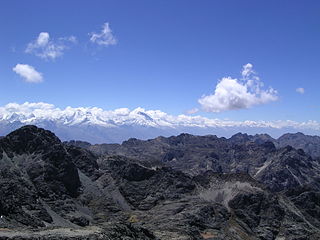
Ancash is a department and region in northern Peru. It is bordered by the departments of La Libertad on the north, Huánuco and Pasco on the east, Lima on the south, and the Pacific Ocean on the west. Its capital is the city of Huaraz, and its largest city and port is Chimbote. The name of the region originates from the Quechua word anqash, from anqas ('blue') or from anka ('eagle').

Hohokam was a culture in the North American Southwest in what is now part of Arizona, United States, and Sonora, Mexico. It existed between 300 and 1500 AD, with cultural precursors possibly as early as 300 BC. Archaeologists disagree about whether communities that practiced the culture were related or politically united. According to local oral tradition, Hohokam societies may be the ancestors of the historic Pima and Tohono O'odham peoples in Southern Arizona.
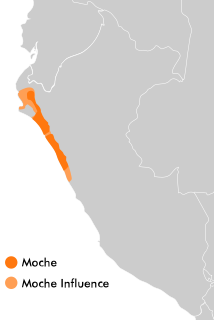
The Moche civilization flourished in northern Peru with its capital near present-day Moche, Trujillo, Peru from about 100 to 700 AD during the Regional Development Epoch. While this issue is the subject of some debate, many scholars contend that the Moche were not politically organized as a monolithic empire or state. Rather, they were likely a group of autonomous polities that shared a common culture, as seen in the rich iconography and monumental architecture that survives today.

Huaraz, founded as San Sebastián de Huaraz, is a city in Peru. It is the capital of the Ancash Region and the seat of government of Huaraz Province. The urban area's population is distributed over the districts of Huaraz and Independencia. The city is located in the middle of the Callejon de Huaylas valley and on the right side of the Santa river. The city has an elevation of approximately 3050 metres above sea level. The built-up area covers 8 km2 and has a population of 120,000 inhabitants, making it the second largest city in the central Peruvian Andes after the city of Huancayo. It is the 22nd largest city in Peru. Huaraz is the seat of the province's Roman Catholic Bishop and the site of the cathedral.
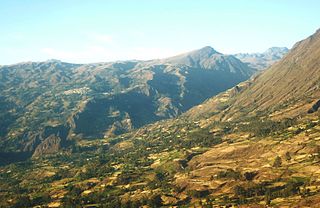
Cabana is a city in Peru. It is the capital of both the Cabana District and the Province of Pallasca in the Ancash Region of northern Peru. Cabana was founded on January 2, 1857, although human habitation there likely predates arrival of the Spanish Conquistadors.
The Santa Valley is an inter-andean valley in the Ancash Region in the north-central highlands of Peru. Due to its location between two mountain ranges, it is known as Callejón de Huaylas, the Alley of Huaylas, whereas "Huaylas" refers to the territorial division's name during the Viceroyalty of Peru.

Huari or Wari is an archaeological site located near the town of Quinua, 22 km northeast of the city of Ayacucho, in the Ayacucho Region, Peru at an elevation between 2600 and 2900 meters. It was the capital city of the Huari Empire and one of the largest urban settlements in ancient Peru.

Chanquillo or Chankillo is an ancient monumental complex in the Peruvian coastal desert, found in the Casma-Sechin basin in the Ancash Department of Peru. The ruins include the hilltop Chankillo fort, the nearby Thirteen Towers solar observatory, and residential and gathering areas. The Thirteen Towers have been interpreted as an astronomical observatory built in the 4th century BC. The culture that produced Chankillo is called the Casma/Sechin culture or the Sechin Complex. The site was awarded UNESCO World Heritage status in July 2021.
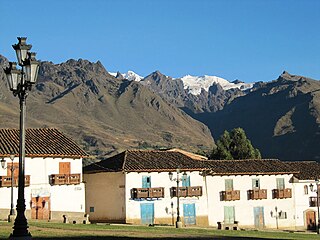
San Martín de Chacas is a Peruvian town, capital of the eponymous district and the Asunción Province, located in the east-central region of Ancash. It has an urban population of 2,082 located at 3,359 meters; and a district of 5,334 people. The district, located in the sub-basin of the Marañon River, has an area of 447.69 km², which represents 85% of the province.

The Pomabamba Province is one of twenty provinces of the Ancash Region in Peru. It was formerly called Pumapampa and today it is also known as "The City of Cedars". It is located at the left bank of the Pomabamba river, at 3,063 meters (10,049 ft) above sea level. It was created by law on February 21, 1861.
Recuay District is one of ten districts of the province Recuay in Peru.

Aija is a town in central Peru, capital of the province Aija in the region Ancash, on the west side of the Cordillera Negra.

Cerro Sechín is an archaeological site in Casma Province of Ancash Region in northern Peru. Dating to 1600 BC, the site was discovered by Peruvian archaeologists Julio C. Tello and Toribio Mejía Xesspe on July 1, 1937. Tello believed it was the capital of an entire culture, now known as the Casma/Sechin culture or Sechin complex. Notable features include megalithic architecture with carved figures in bas-relief, which graphically dramatize human sacrifices. Cerro Sechín is situated within the Sechin Alto Complex, as are Sechin Bajo, and Taukachi-Konkan. There is a small on-site museum. The slabs at Cerro Sechin may represent the central Andes' oldest known monumental sculpture.

Painting in the Americas before European colonization is the Precolumbian painting traditions of the Americas. Painting was a relatively widespread, popular and diverse means of communication and expression for both religious and utilitarian purpose throughout the regions of the Western Hemisphere. During the period before and after European exploration and settlement of the Americas; including North America, Central America, South America and the islands of the Caribbean, the Bahamas, the West Indies, the Antilles, the Lesser Antilles and other island groups, indigenous native cultures produced a wide variety of visual arts, including painting on textiles, hides, rock and cave surfaces, bodies especially faces, ceramics, architectural features including interior murals, wood panels, and other available surfaces. Many of the perishable surfaces, such as woven textiles, typically have not been preserved, but Precolumbian painting on ceramics, walls, and rocks have survived more frequently.

Marcahuamachuco is an archeological site of Pre-Incan ruins in the La Libertad Region of Peru. Although less well-known than other sites, it is considered significant and has been referred to by archaeologists as "Machu Picchu of the North" and "The Jewel of La Libertad."
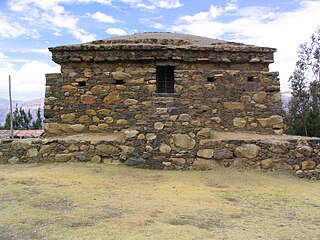
Wilcahuaín, Willcahuaín, or Huilcahuaín is an archaeological site in Peru. It is located near the village of Paria, 7 km northwest of the city of Huaraz, Ancash; at an elevation of 3,400 m (11,200 ft).
Honcopampa or Joncopampa is an archaeological site in Peru. It is situated in the Ancash Region, Carhuaz Province, Aco District, at a height of about 3,500 metres (11,483 ft). Hunqupampa is considered one of the most important archaeological sites of the Callejón de Huaylas. It lies in the little populated place named Hunqupampa (Joncopampa).
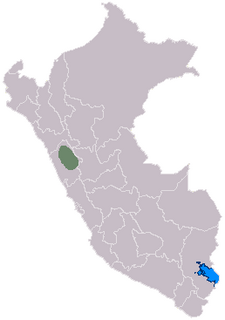
The Recuay culture was a pre-Columbian culture of highland Peru that flourished from 200 BCE to 600 CE and was related to the Moche culture of the north coast. It is named after the Recuay District, in the Recuay Province, in the Ancash Region of Peru.
Stephanie Wynne-Jones is an Africanist archaeologist, whose research focuses on East African material culture, society and urbanism. She is Senior Lecturer and Deputy Head of the Department of Archaeology at the University of York. She previously worked as Assistant Director of the British Institute in Eastern Africa (2005-2008) and remains a Trustee and Member of the BIEA Governing Council. In 2016, Wynne-Jones was elected to Fellowship of the Society of Antiquaries of London. Wynne-Jones is one of the Core Group at the Danish National Research Foundation Centre of Excellence in Urban Network Evolutions (Urbnet), Aarhus University. Between 2015 and 2017 she was a Pro Futura Scientia Fellow at the Swedish Collegium for Advanced Study, Uppsala.

Pampas Grande, founded as San Jerónimo de Pampas, It is a Peruvian town, capital of the homonymous district, located in the central part of the so-called Callejón de Huaylas in the Ancash region, about 4 hours from Huaraz and 9 from Lima. It has an approximate population of 1044 inhabitants, located at an average altitude of 3690 m a.s.l. It has a cold climate with average temperatures of 17 °C in summer and 12 °C in winter.
















